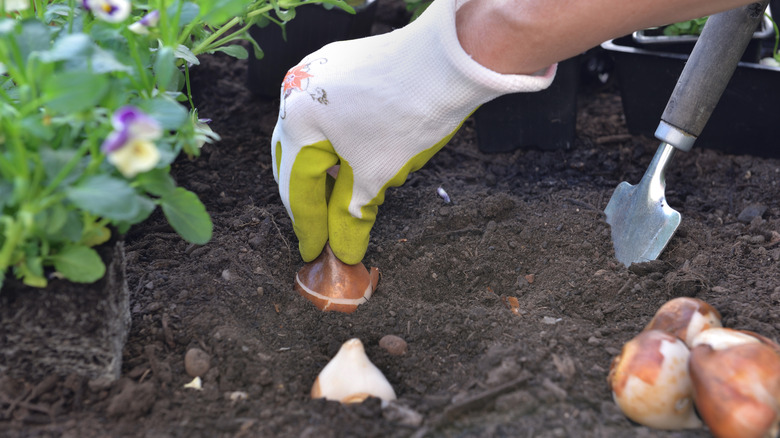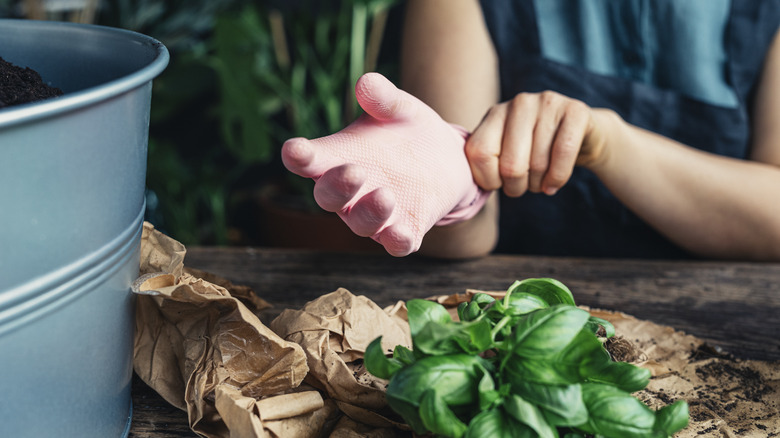In their carefree acrobatic mode, bushy-tailed squirrels are delightful to watch — until they cross the line and start snacking on your ornamental bulbs. The sight of freshly-dug soil after you’re done planting tulips, crocuses, or any other flowers inspires them to attack the site, hoping to find a hoard of nuts. Discovering bulbs in their place doesn’t make them less interested, as the always-famished critters can consider flowers to be tasty meals, too. Although protecting the planting site by covering it with chicken wire is one way to get rid of squirrels, many gardeners find this hack to be an eyesore and expensive proposition. Under such circumstances, it’s important to complete one gardening step before planting flowering bulbs: soak them in a thiram-based repellent.
Belonging to the dithiocarbamate chemical class, thiram is a sulfur-based fungicide that protects seeds and their yields from fungal diseases. However, it also functions as a taste repellent, disgusting and driving out the squirrels after they start to munch on the treated bulbs. As a bonus, it can also keep rabbits, deer, and other animals from eating your bulbs, too.
Using thiram to deter squirrels

Thiram’s beauty when used to keep squirrels from digging up bulbs lies in its bitterness. Unlike area repellents, thiram doesn’t combat rodents by deterring them outrightly with something like an overpowering scent. Rather, it banks upon the squirrels nibbling on the flower bulbs and tasting its acrimony, therefore turning them away from eating further. Fortunately, the pests feel the same way about the sour flavor as humans: a total turn-off. While this won’t stop the creatures from leaving behind chew marks on some of your bulbous plants, it will minimize the scale of destruction. This is because it sends out a loud and clear message that there’s no buffet to be had and they must look for greener pastures.
To try out this hack, start by drying out the bulbs if they aren’t already dry. Next, combine 8 gallons of water with 1½ pints of the thiram-based repellent in a container. Stir the solution and dip in the ornamental bulbs. Later, spread them out to dry if storing them for future use or plant them immediately. When planting, ensure the bulbs are completely covered with soil. The protective thiram coating should last about six months. For added protection, apply the product to sidings and fences around the area, too.
Be cautious while using thiram

Although thiram answers your “what deters squirrels from bulbs” question, it has its downsides. For starters, you can’t use it without protection, as even slight contact can cause skin dermatitis. Hence, wearing chemical-resistant rubber gloves, long-sleeve shirts, and full pants is necessary throughout suspension-making and bulb-planting. Moreover, avoid visiting your yard for a full day after planting the thiram-treated bulbs. Also, these bulbs shouldn’t be ingested or grazed on and should be stocked far away from your food.
Further, the chemicals are non-selective and can harm other beneficial insects and birds. While they generally absorb into the soil which lowers the possibility of groundwater contamination, surface runoff can adversely affect aquatic animals as well. However, the Environmental Protection Agency has disallowed thiram’s use in residential areas as a fungicide because it can pose major health risks to kids and pets. Instead, they condone its use when contained in animal repellents, as they carry lower concentrations of the chemical. A 75% concentration has been approved to protect seeds from thirteen-lined ground squirrels, but many repellents you can buy at home improvement stores or online contain smaller percentages of thiram. Still, it’s important to always keep kids and pets away from this chemical.




